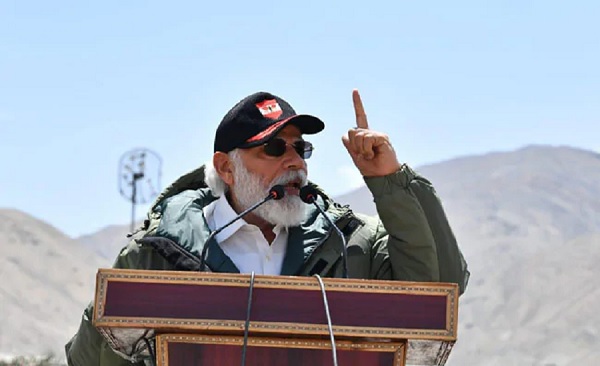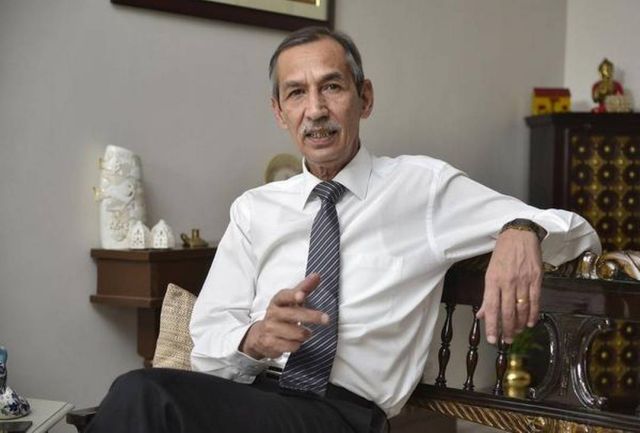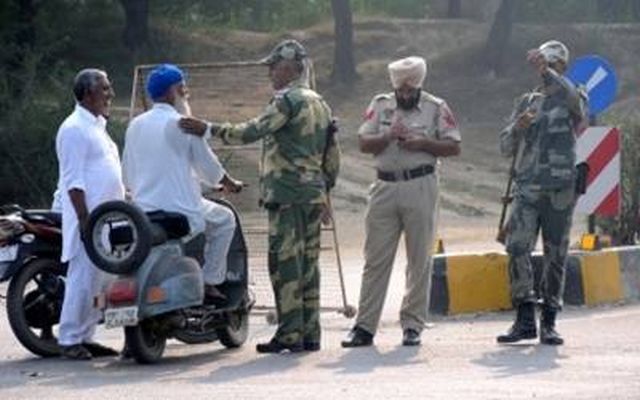
by admin | May 25, 2021 | Corporate, News

Prime Minister Narendra Modi addressing the Jawans at 11,000 feet height he sent a powerful message to China that it’s no more LAC, its LOC now, though he never uttered such words.
Syed Ali Mujtaba
PRIME MINISTER Narendra Modi’s visit to a forward post in Ladakh served as a morale booster for the forces and by addressing the Jawans at 11,000 feet height he sent a powerful message to China that it’s no more LAC, its LOC now, though he never uttered such words.
“The age of expansionism is over. History knows that expansionist forces have either lost or were forced to turn back. The weak can never accomplish peace, the brave do,” PM said from the top of the mountain.
The Prime Minister was trying to say that India will no more tolerate the Chinese aggression. In other words what he meant henceforth there is no more going to be Line of Actual Control and it will be Line of Control that India will protect.
India’s border with China traverses through the Union territory of Ladakh (1,597 km), Himachal Pradesh (200 km), Uttarakhand (345 km), Sikkim and Arunachal Pradesh (1126 km).
India says it shares a 3,488 km border with China. China says it shares only 2,000 km of border with India. The difference of 1,126 km is Arunachal Pradesh that India controls but China claims it its own. Also China does not recognize the 362 km boundary claim of India.
All this is because India insists on the McMahon line that British delineated as the boundary between India and China that China does not recognise. It has imaginarily and unilaterally demarcated a Line of Actual Control that it has dictated after the 1962 war.
Also read: Modi Rallies Troops at China Border, as Beijing Urges Caution
So the fundamental difference between India and China is the land boundary question of 1,488 km and two countries hold different perceptions of the boundary line at different places of the imagined border.
Going back to history, there was no demarcated boundary between India and China since antiquity. What actually was only a frontier between the two countries?
The Princely state of Jammu and Kashmir though held the sovereignty of Ladakh but had long given its suzerainty to China that controlled most of Ladakh.
After the merger of the Princely state of Jammu and Kashmir to Indian Union, Ladakh became part of the Indian territory, with conflicting claims between India and Pakistan over the entire territory of the erstwhile princely state, with China still holding its sway over eastern portion of Ladakh.
In 1949, China that actually held suzerainty over Tibet occupied it and lay claim over its sovereignty. It made Tibet its autonomous region to which India and other countries objected. Meanwhile, India incorporated the McMahon line in its Constitution in 1950 and demarcated its boundary with China, to which China objected.
There were protests in Tibet against China’s occupation that was alleged to be supported by India. China in order to quell the uprising started making the concrete road in the Aksai Chin region of Ladakh to carry its troops from its Xingjian province to Tibet.
China completed this link road in 1957 amidst India’s objections that Aksai Chin is Indian territory. The situation on the ground deteriorated that led to the Sino-Indian War of 1962. The war ended with a unilateral ceasefire by China.
After the end of the war, Line of Actual Control emerged that was mutually agreed upon but remained un-demarcated lines with both India and China having different perceptions over it. Both India and China moved back its troops to 20 kilometres from the Line of Actual Control that divided areas under Indian and Chinese control.
It is because of unresolved and un-demarcated boundary issues with China that transgressions and face-offs between both side’s patrols happened at regular intervals at different locations of the LAC.
The situation was resolved through the mutually established protocols to maintain peace and tranquility on the border. These protocols with China were established to resolve issues amicably at the local formation commander level and the resolving mechanism involved the local Border Personnel Meeting (BPM).
The rapprochement between the two countries reached in 1976 enabled India and China to initiate High Level border talks in 1981 to find a solution to the vexed problem. After eight rounds, the talks broke down in 1987.
In 1988, following Prime Minister Rajiv Gandhi’s visit to China, the Joint Working Group (JWG) was set up to look into the border problem.
The two countries signed agreements in 1993 and 1996 to respect the Line of Actual Control. In 1993, the Agreement on the Maintenance of Peace and Tranquility along the Line of Actual Control (LAC) was signed. The India-China Expert Group of Diplomatic and Military Officers was set up to assist the JWG.
In 1996, the Agreement on Confidence Building Measures (CBMs) in the Military Field along the LAC was signed. In 2003, two special representatives (one each from India and China) were appointed to find a political solution to the border dispute. Till 2009, these two special representatives had held 17 rounds of talks, but it seems they did not make much headway.
The Modi government appointed National Security Advisor Ajit Doval as Special Envoy for talks with China but he has hardly done anything noticeable.
Then the India and China stand-off took place in 2017 at Doklam. After some 70 days of being engaged in combat mood, the two sides disengaged.
The Doklam issue was discussed in the Wuhan Summit in 2018 and two nations decided to issue “strategic guidance” to their militaries to strengthen communications so that they can build trust and understanding.
This was further reciprocated by the second India-China informal summit at Mamallapuram near Chennai in 2019 that was to take forward the Wuhan agenda.
However, in May 2020 clashes broke out between Indian and Chinese soldiers first at Pangong Lake on May 5 and then at Naku La sector in Sikkim on May 9. This was followed by violent clashes in Galwan Valley in Ladakh on June 15, when 20 Indian soldiers were brutally killed. Since then Indian and Chinese troops have moved in extra troops to positions opposite each other and currently it is in eyeball to eyeball contact mode.
What is seen in the attempts so far made to resolve the issues several times that the problem has remained the same and there is no forward movement because of the vast difference in perception about the actual boundary line between the two countries?
This time with the Prime Minister visiting the forward location in Ladakh, he has sent the message to the Chinese that he is not going to take things lying down any more.
The Prime Minister’s visit to Ladakh gives ample hint that India wants to dig deep into its position and has unofficially declared that there is no more LAC and what remains is the LOC that India is protecting now.
____________
Syed Ali Mujtaba is a journalist based in Chennai. He can be contacted at syedalimujtaba2007@gmail.com

by admin | May 25, 2021 | Interviews

Lt. General (retd) Deependra Singh Hooda
By Mohd Asim Khan,
New Delhi : The Indian side was prepared for escalation — in case Pakistan chose to do so — while conceiving and executing the 2016 surgical strikes by crossing the Line of Control (LoC) along the Jammu and Kashmir border, according to the army general who oversaw the strikes.
“We had sort of war-gamed all the contingencies of what could be the impact of the surgical strike. And one of the things that we did consider was that in case Pakistan decides to escalate, then what do we have to do,” Lt. General (retd) Deependra Singh Hooda, who planned and oversaw the execution of the operation as the General Officer Commanding (GoC) of the Northern Command, told IANS in an interview.
“And we had put plans in place of what is to be done in various areas. I can’t go into details, but definitely it was something that we considered,” he added.
On the intervening night of September 28-29, 2016 — 11 days after the Uri attack by militants from across the border — a group of Indian Army commandos crossed the LoC and in a pre-emptive strike destroyed several launch pads of militants in Pakistan-administered Kashmir. The Army estimated that 30-70 militants and their handlers were killed in the strike The highly-decorated officer retired from the Army on November 30th, the same year.
Hooda also said they knew there would only be a “limited” kind of response from Pakistan side, if at all.
“I was clear in my mind that the surgical strike was not going to lead to something like an all-out war between the two countries. That wouldn’t have happened because Pakistan military’s capabilities in that sense are limited. So I am not sure they would have decided to escalate to that extent,” Hooda said.
“But, yes, some local border incidents, in a kind of escalation, was something that we had in our mind,” he added.
Hooda said that this was not the first time that such a cross-LoC operation was done — in fact such things go on a “fairly regular basis” in a limited manner — but the surgical strike of 2016 was different from earlier similar operations primarily in two ways.
“Similar operations had been done in the past on multiple occasions. It’s been happening for years. It’s not as if it was for the first time. The difference was that this time around the scale was larger, and more importantly, the government decided to own up and say yes we did it. Whatever had been done in the past was never officially accepted,” Hooda said.
He said that it was a “very high risk” operation and he was worried about what would happen if something went wrong — like a soldier being captured — or how to evacuate a soldier if he was injured or killed.
“The exfiltration after the operation was actually a more risky task. But again, we had planned the contingencies. We had prepared to send more people across to get our boys out,” he said.
He said that Pakistan kept saying the surgical strike had not happened, but in fact there was considerable panic on the Pakistani side.
“We were listening to their radio conversation after the strikes and there was a fair amount of panic on the other side. They cancelled their leaves, more high alerts were sounded, and they kept telling each other to be careful as ‘these guys may come across again’. There was psychological pressure on the Pakistanis,” Hooda said.
After the operation, Hooda said, the morale of India soldiers went “sky high”.
“You could have seen it in their faces. The fact that they had gone across the border, done the operation and came back successfully without anybody getting injured was a great feeling. It was a complex operation. There was a huge confidence that we can do it again, which is a big thing because if you have a failure, then there is always a doubt in your mind whether we should attempt something like this again,” Hooda said.
The general, however, admitted that infiltration had neither stopped, nor had come down, after the surgical strikes. Instead, it appeared to have slightly gone up.
“They kept trying. And I believe there was a feeling that this has been done to us, we should try and do something back. Now, they can’t do it conventionally because their army cannot do it. So they kept sending infiltrators,” he said.
“Thousands and thousands of them (militants) are there. The Pakistani army thinks these are expendable chaps, toh inhe bhejte raho (keep pushing them across the border),” he added.
How does he feel when people raise questions on the veracity of army action or use of words like farcical strikes?
“Well, it’s a bit disappointing. People should have no doubt when an army officer of the rank of DGMO (Director General Military Operations) comes in front of the camera on live TV and announces that this has been done. Officials at that level cannot give irresponsible statements,” Hooda said.
(Asim Khan can be contacted on mohd.a@ians.in )
—IANS

by admin | May 25, 2021 | News, Politics
 New Delhi : The Congress on Thursday accused the Modi government of using the 2016 surgical strike carried out in Pakistan as “political fodder” to gain votes and listed many similar strikes done in the last two decades to assert this was not the first action of its kind.
New Delhi : The Congress on Thursday accused the Modi government of using the 2016 surgical strike carried out in Pakistan as “political fodder” to gain votes and listed many similar strikes done in the last two decades to assert this was not the first action of its kind.
Congress leader Randeep Singh Surjewala’s comments came a day after the release of the video footage of the Indian Army’s surgical strikes in September 2016 when troops crossed the Line of Control (LoC) to attack terror hubs in Pakistan-administered Kashmir.
Surjewala told reporters that BJP President Amit Shah had “dishonoured” the 70-year-long history of bravery and sacrifice of the armed forces by making a “disgraceful statement” on October 7, 2016 that the “Indian Army had crossed the LoC for the first time in 68 years”.
Stressing that Congress President Rahul Gandhi and her predecessor Sonia Gandhi supported the armed forces and the government in the 2016 action, Surjewala said the Army had conducted strategic surgical strikes “with utmost precision and effective penetration” at different times in the last two decades.
He listed eight “surgical strikes” conducted prior to 2016.
“We are proud that our forces successfully conducted multiple surgical strikes over the last two decades, particularly post 2000 — January 21, 2000 (Nadala Enclave, across Neelam river); September 18, 2003 (Baroh Sector, Poonch); June 19, 2008 (Bhattal Sector, Poonch); August 30 to September 1, 2011 (Sharda Sector, across Neelam river Valley in Kel); January 6, 2013 (Sawan Patra Checkpost); July 27 to 28, 2013 (Nazapir Sector); August 6, 2013 (Neelam Valley); January 14, 2014; September 28 to 29, 2016.”
He said the Modi government sought credit for the sacrifices of the soldiers but had “utterly failed” to provide the direction, vision and policy for dealing with Pakistan and checkmating Pakistan-sponsored terrorism.
“No wonder the apathy and incapacity of the Modi government has resulted in the sacrifice of 146 soldiers, more than 1,600 ceasefire violations by Pakistan and 79 terrorist attacks post September 2016,” Surjewala said.
“Doublespeak of the Modi government and the BJP’s stand is reflected in the stepmotherly treatment of our armed forces, both in terms of providing for security apparatus as also in slashing their budgetary allocation.”
Surjewala alleged that Army Vice Chief Sarath Chand was “forced” to say that 68 per cent of all equipment was vintage.
“On account of budgetary cuts, procurement from ordinance factory is being reduced from 94 per cent to 50 per cent, which will force our soldiers to buy uniforms, combat dress, belts and shoes on their own.”
Surjewala said the report of the Parliamentary Committee on Defence highlighted lack of money for emergency purchases by Armed Forces after the Uri terror attack, the surgical strike and the Doklam standoff with China.
—IANS




